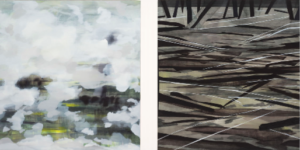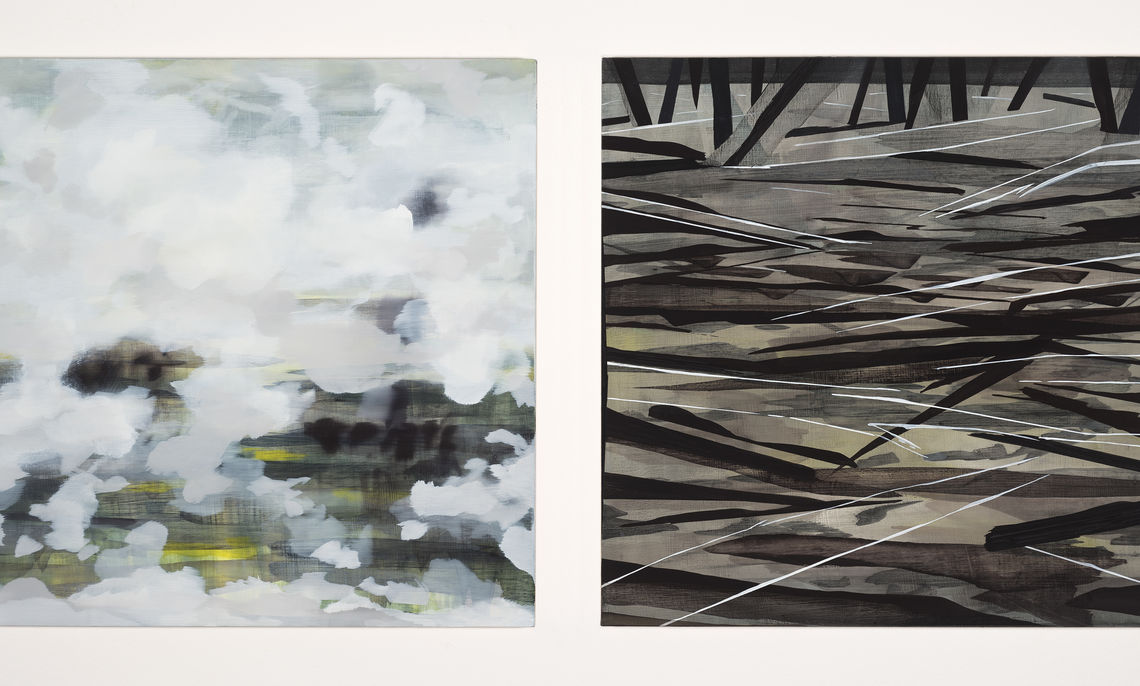By Vanessa Chen || Staff Writer

Franklin & Marshall Assistant Professor of Art Magnolia Laurie opened her art exhibition “your land/my land” in Phillips Museum of Art on Tuesday, January 24. Professor Laurie was also in the 2015 Sondheim Artscape Finalist Exhibition at the Baltimore Museum of Art, and exhibited “GROUND SHIFT” at Frosch & Portmann in New York.
In her opening day speech, Professor Laurie said she wished to create poetic questions about how we live on our land. Her artwork consists of abstract landscape oil paintings which depict man-made marks on nature. Laurie uses smoke, fences, and iron structures, to illustrate the impact man has on land without actually depicting human beings in her work.
When I spoke to Professor Laurie, she said that humans had the instinctive desire to create, and to leave a mark on the world. She thought creation was good, the process was beautiful, but it was in the end, a futile act and could produce damage more long-lasting than the man-made structures themselves.
The exhibition depicted neglected, deteriorating human-built structures and smoke that would quickly dissipate in real time. The color scheme gave off a melancholic and nostalgic feeling, mourning human creation’s lost glory, and the hope once embodied. Professor Laurie said that she not only saw futileness in her subjects, but also in the creation of her own art. She said that as an artist she was driven to create and to leave her mark on the world, however, it was uncertain how much impact her creations could actually make.
Another major theme of the exhibition was how we use and value our land, especially how our actions impact the environment. In an era of raising environmental concerns, Professor Laurie’s exhibition implores the viewer to think about important questions about nature and its destruction.
In one of her paintings, “ash and moss, hold us together,” human creation and nature were entangled in a way that felt dangerous. Ash is a pollutant, a by-product of industrial greed. Moss is soft, damp and usually rich in its greenness and texture. In the painting, the two were impossible to distinguish. Thick slanted black lines, and thin slanted white lines charged from the edges of the frame towards the center. The white lines seem to depict the winds that blown ash to the moss. The landscape looks dirty due to the extensive use of murky greens and browns and the energetic, slanted lines depicted a turbulent scene.
The exhibition left me thinking about the uncertain future of our environment, which is harmed by human’s constant desire to make and to claim. We mindlessly, obsessively create, then discard. What we throw away impacts nature for a substantial amount of time. The iron structures, the fences, and the smoke in Professor Laurie’s paintings, and all around us, harshly remind us of human excess and carelessness.
Magnolia Laurie’s “your land/my land” exhibition will be on display in the Phillips Museum of Art until April 27, 2017.
Sophomore Vanessa Chen is a staff writer. Her email is wchen1@fandm.edu.
